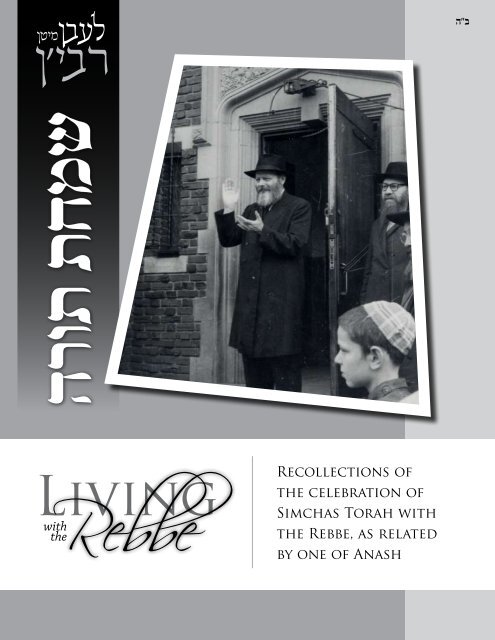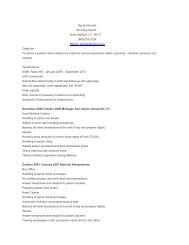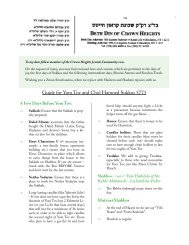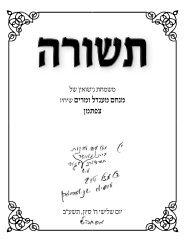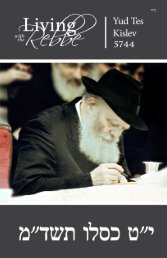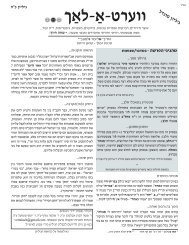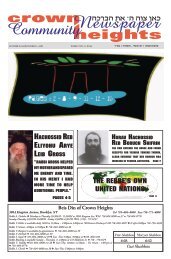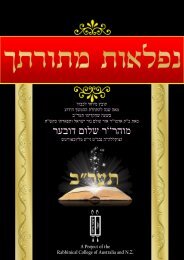Simchas Torah booklet (PDF) - COLlive.com
Simchas Torah booklet (PDF) - COLlive.com
Simchas Torah booklet (PDF) - COLlive.com
You also want an ePaper? Increase the reach of your titles
YUMPU automatically turns print PDFs into web optimized ePapers that Google loves.
ב"ה<br />
לעבןמיטן<br />
רבי'ן<br />
1<br />
שמחת תורה<br />
Living<br />
Rebbe<br />
with<br />
the<br />
Recollections of<br />
the celebration of<br />
<strong>Simchas</strong> <strong>Torah</strong> with<br />
the Rebbe, as related<br />
by one of Anash
2<br />
Introduction<br />
instantaneously united to be<strong>com</strong>e like<br />
one entity, “K’ish Echad, B’lev Echad,”<br />
all together enjoying every moment,<br />
basking in the Rebbe’s aura. The<br />
Rebbe’s every move orchestrated the<br />
song and dance of the Chassidim, be<br />
it by the clapping of his hands or by<br />
others signs of encouragement that he<br />
cast out to us throughout the night.<br />
I<br />
spent <strong>Simchas</strong> <strong>Torah</strong> by the<br />
Rebbe ten times between the<br />
years 5736-5748. Needless to<br />
say, that after so many years I’m<br />
left with many fond memories of the<br />
unforgettable moments that I was<br />
privileged to see or, more accurately,<br />
live through and experience. I’ll<br />
attempt to organize my thoughts in<br />
order to <strong>com</strong>e out with a reasonable<br />
outline of what transpired in the<br />
Rebbe’s court during that forty-eight<br />
hour period.<br />
Firstly, I’d like to clarify the following:<br />
anyone who shared those experiences<br />
with me will agree that they are<br />
absolutely indescribable. The emotions<br />
and sensations which we felt simply<br />
cannot be articulated in words. Bearing<br />
that in mind, let us begin…<br />
I’d like to begin with a few<br />
introductory words about what the<br />
atmosphere in 770 was like at the time.<br />
I’m often reminded of the Frierdiker<br />
Rebbe’s Sicha in which he describes<br />
the “Yechidus-Hakofos” of the Alter<br />
Rebbe. He quotes the words of the<br />
renowned Chossid, R’ Pinchas Reizes,<br />
who said that after partaking in these<br />
Hakofos he began to understand what<br />
it must have been like to be Oleh<br />
L’regel to the Beis Hamikdash and feel<br />
a G-dly sensation. We as Chassidim<br />
unquestionably felt the same way in<br />
regards to our Rebbe’s Hakofos.<br />
When the Rebbe entered the Shul<br />
for Hakofos, the entire crowd<br />
The energy on <strong>Simchas</strong> <strong>Torah</strong> was<br />
that of another caliber. Although it is<br />
true, that throughout the year, during<br />
Farbrengens and on other occasions<br />
the Rebbe did hearten the singing,<br />
<strong>Simchas</strong> <strong>Torah</strong> however, was just at<br />
another level altogether.<br />
The Rebbe often quoted the words<br />
of the Frierdiker Rebbe who exposed<br />
us to the idea of the “Chassidishe<br />
Ushpizin,” and he would add that on<br />
Shmini Atzeres the Frierdiker Rebbe is<br />
the Ushpizoh. I recall when the Rebbe<br />
explained that on Shmini Atzeres, the<br />
Frierdiker Rebbe does not only arrive<br />
as a guest but he’s actually the “Baal-<br />
Habos”!<br />
Indeed, having been with the Rebbe<br />
on <strong>Simchas</strong> <strong>Torah</strong> I can tell you<br />
with utmost certainty that this is the<br />
Rebbe’s day. The energy was in the air;<br />
it mesmerized all of those present, and<br />
penetrated into the deepest recesses of<br />
their hearts.<br />
To better explain myself, I’ll relate<br />
the following story: I once came<br />
across a Litvishe Rosh Yeshivah in<br />
a Chabad house, who told me how<br />
on one occasion he was privileged to<br />
be present at the Rebbe’s Hakofos<br />
on <strong>Simchas</strong> <strong>Torah</strong>. He was so moved<br />
by the experience that he decided to<br />
<strong>com</strong>e back again on the following<br />
year, so that his son would have the<br />
opportunity to be there as well. His<br />
heart just didn’t allow him to deprive
3<br />
his son of living through such an<br />
uplifting experience, and so he was<br />
<strong>com</strong>pelled to <strong>com</strong>e back again. You<br />
see, by the Rebbe one didn’t <strong>com</strong>e to<br />
see Hakofos, rather to live them and<br />
experience them first-hand.<br />
Throughout the entire Yom Tov,<br />
especially on <strong>Simchas</strong> <strong>Torah</strong> and during<br />
the Hakofos themselves, we felt as<br />
if the entire world didn’t exist, as if<br />
it vanished into thin air. As if we all<br />
transcended to a dimension higher than<br />
time and space altogether.<br />
In our “world”, all that existed were<br />
the Nigun that we were singing, along<br />
with the Rebbe’s encouragement to it.<br />
One could see on the Rebbe’s face the<br />
intensity of the joy, and specifically<br />
when he would place his eyes upon<br />
you, you were possessed by some inner<br />
strength and <strong>com</strong>pelled to dance and<br />
rejoice with every last ounce of it.<br />
One year, a friend of mine had a<br />
broken leg and for the period of<br />
Shmini Atzeres and <strong>Simchas</strong> <strong>Torah</strong><br />
he had to use crutches. Due to this,<br />
the “Vaad Hamisader” allowed him<br />
to stand near the Rebbe’s place for<br />
Hakofos, in order that he not be<br />
pushed around. Later on, I jokingly<br />
asked him: “Must I walk with crutches<br />
as well in order to be close to the<br />
Rebbe during Hakofos?” He replied:<br />
“What do you think; standing near<br />
the Rebbe during Hakofos is easy? The<br />
Rebbe gazes upon you constantly, and<br />
you’re forced to sing and dance with<br />
such Chayus, you never even knew you<br />
had!”<br />
These are definitely moments that no<br />
description can do justice to, and no<br />
words can express. The outstanding<br />
heat and how we were sweating meant<br />
absolutely nothing to us; we just<br />
danced and danced so long as the<br />
Rebbe would motion with his holy<br />
hand. This holds true for the myriads<br />
of Chassidim filling 770 at the time<br />
[about seven to eight thousand men].<br />
Each and every one of them did not<br />
think about anything else, but to see<br />
the Rebbe and catch another glimpse<br />
of his face. And the Rebbe, on his part,<br />
spared no energy, singing and dancing,<br />
encouraging the Chassidim with all his<br />
might - Ah! Fortunate is the eye that<br />
saw all of this! All were on the highest<br />
of spirits, even while the Rebbe was<br />
not formally encouraging the singing,<br />
all his movements expressed his utmost<br />
joy!<br />
Now, having <strong>com</strong>pleted this humble<br />
introduction, which to the best of my<br />
abilities, still cannot <strong>com</strong>e close to<br />
bring out the ecstasy and joy which was<br />
felt in the air - let’s talk about some<br />
occurrences which stick out in my<br />
mind from those unforgettable days:<br />
Maariv:<br />
I<br />
first came to the Rebbe in 5736.<br />
In those years (i.e. through 5738)<br />
the bleachers covered the entire<br />
length of the wall until the ceiling<br />
on both sides of the Shul. I managed<br />
to get a spot between the first and<br />
second bleacher, under the women’s<br />
section that coincides with Kingston<br />
Ave. When the Rebbe entered the<br />
Shul, absolute silence prevailed; the<br />
Rebbe arrived to his place, placed his<br />
Siddur on the Shtender and began<br />
to sing the tune of “Zol Shoin Zein<br />
Di Geula ...” I can still remember the<br />
roar of the crowd that followed as<br />
it instantly joined the singing, and<br />
how everyone spontaneously started<br />
dancing. This was perhaps somewhat<br />
of an introduction to the exhilarating<br />
atmosphere of <strong>Simchas</strong> <strong>Torah</strong> in the<br />
Rebbe’s court.<br />
Until 5738 (* The Year when the<br />
Rebbe suffered a very big heartattack<br />
during Hakofos), Maariv of<br />
Shmini Atzeres started approximately<br />
at 7:00, with Hakofos following at<br />
around 9:30. After 5738 efforts were<br />
made so as not to burden the Rebbe<br />
unnecessarily, and it was thus decided<br />
to start Hakofos at 9:00. The same was<br />
with the auctioning of the Pesukim<br />
of Ato Horeisa: until 5738, this<br />
procedure would extend for almost two<br />
and a half hours, whereas from 5739<br />
onwards, most of the sales were done<br />
beforehand, with very few remaining to<br />
be <strong>com</strong>pleted at the time of Hakofos<br />
itself.<br />
During the years at which I was present<br />
the Chassidim generally sang the Nigun<br />
of “Ksiva Vachasima Tova” (without<br />
the words) and danced in circles while<br />
waiting for the Rebbe to <strong>com</strong>e down,<br />
and then, upon His appearance, they<br />
continued with the same tune. A most<br />
memorable moment was when the<br />
Rebbe reached his place and turned<br />
around towards the crowd to encourage<br />
the singing by clapping his hands. The<br />
excitement that overtook us on that<br />
second was electrifying.
4<br />
Pre-Hakofos<br />
Farbrengen:<br />
Before Hakofos there was always<br />
a Farbrengen. These were<br />
always full of excitement and<br />
very uplifting. The crowd, at least in<br />
the beginning, was not so numerous,<br />
as most of the Bochurim and Anash<br />
were on Tahalucha, and the Shul was<br />
set up accordingly. I remember these<br />
Farbrengens as some very special<br />
moments, due to both the content<br />
and special style of the Sichos, as well<br />
as the unique manner by which the<br />
Rebbe encouraged the singing of the<br />
Chassidim. Everything was different<br />
than usual, so much more joyful. Now<br />
I’ll attempt to relate some of the<br />
things I remember, that transpired<br />
during these special Farbrengens:<br />
In 5736, during the Farbrengen, the<br />
Rebbe asked that a Nigun containing<br />
English words (“Sfas Hamedina”)<br />
be sung. The Bochurim immediately<br />
began to sing “From 770 we’re<br />
marching out…” but the Rebbe<br />
did not show any response, so they<br />
understood that this was not what<br />
the Rebbe wanted to hear. In the<br />
meantime, the Rebbe turned to R’<br />
Berel Zaltzman and said, “Nu! Sing a<br />
Nigun in Russian!” R’ Berel sang the<br />
Russian song “Mi Chabadniki…”<br />
while the Rebbe encouraged the<br />
singing. Then the Rebbe once again<br />
requested a Nigun in English, asking<br />
“Where are the camp counselors?”<br />
The Bochurim began to sing “Just one<br />
Shabbos, just one <strong>Torah</strong>…” and the<br />
Rebbe suddenly began to encourage<br />
the singing very strongly!<br />
The Rebbe then requested that a<br />
Nigun be sung in French, adding that<br />
although the Alter Rebbe fought the<br />
French, a Nigun should still be sung.<br />
The French Guests began to sing their<br />
National Anthem, and the Rebbe<br />
encouraged the singing, turning all the<br />
while to his right where the French<br />
guests were situated, paying special<br />
attention to R’ Meir Abuhaseira<br />
(the Chossid to whom the Rebbe<br />
always signaled to whistle). When<br />
they finished, the Rebbe asked that a<br />
Nigun be sung in Yiddish (“Maame<br />
Loshon”) so the Chassidim sang “Zol<br />
Shoin Zein Di Geula…” and with its<br />
conclusion, the Rebbe instructed to<br />
sing a Nigun in Loshon Hakodesh,<br />
“The source of all other languages,”<br />
and they sang “Mipi Kel”.<br />
At the conclusion of the Farbrengen,<br />
R’ Mordechai Taleshevsky stood up<br />
to make announcements about the<br />
arranging of the Shul for Hakofos;<br />
as he always did after all such<br />
Farbrengens. This time however, the<br />
Rebbe instructed him to stand up on<br />
the table. When R’ Moedechai began<br />
to shout “Shaa Shtiler!” the Rebbe<br />
said “Say it three times as one does<br />
at Kol Nidrei!” He repeated the call<br />
three times, but evidently he did not<br />
understand what the Rebbe meant with<br />
Kol Nidrei, so the Rebbe explained,<br />
“Say it three times and each time, raise<br />
your tone of voice a bit,” and that’s<br />
what he did. All the while, the Rebbe<br />
was smiling very broadly. After that,
5<br />
the Rebbe began to sing “I Vadyemi”<br />
(without the words), and while<br />
encouraging the singing immensely, the<br />
Rebbe left the Shul.<br />
That’s what I remember from 5736.<br />
But each year had its own special<br />
occurrences. One year, for example,<br />
I recall that the Rebbe rebuked<br />
the Chassidim for needing specific<br />
instructions to sing; he explained how<br />
on <strong>Simchas</strong> <strong>Torah</strong> one must be so<br />
jolly and happy, to the extent where<br />
he spontaneously initiates the singing.<br />
The Chassidim immediately began<br />
to sing the tune of “Ksiva Vachasima<br />
Tova” with great enthusiasm, and<br />
the Rebbe began to encourage the<br />
singing vigorously, continuing for forty<br />
minutes consecutively!<br />
Another episode:<br />
In 5744, the Rebbe mentioned during<br />
the Farbrengen that with the power<br />
of <strong>Torah</strong>, every Jew has the ability<br />
to bless, and with that, the Rebbe<br />
began to chant, “Yivorechicha Adnoi…<br />
Yo’er Havaye… Yisa Havaye…<br />
Va’ani Avorachem”. (In a Sicha later<br />
on, the Rebbe explained why he had<br />
not concluded the Possuk with the<br />
words “V’somu…”as customary.) All<br />
the Chassidim repeated the Pesukim<br />
afterwards and the Rebbe answered<br />
“Amen”.<br />
[Beginning from the year 5739, a<br />
very well-furnished Kiddush was<br />
arranged on the service lane of Eastern<br />
Parkway (contributed by R’ Nochum<br />
Markowitz); something which pleased<br />
the Rebbe very much, to the extent<br />
that, although generally, there were<br />
only forty five minutes between the<br />
Farbrengen and Hakofos, the Rebbe<br />
mended this intermission to be a<br />
full hour, when he heard about the<br />
Kiddush. During this Kiddush in<br />
5744, I fondly remember how, in<br />
accordance with the Rebbe’s words<br />
during the Farbrengen, Chassidim were<br />
going about and blessing each other; it<br />
was a beautiful sight to behold.]<br />
Another episode:<br />
In 5746, towards the end of<br />
the Farbrengen, the Rebbe said<br />
“Lechayim” and drank the entire cup,<br />
holding it up-side-down for a while<br />
until the last drops escaped out of the<br />
cup. The Rebbe then raised the cup<br />
up high so that all can see that it was<br />
in his hand in an overturned position.<br />
I still recall the amusing expression<br />
on the Rebbe’s face at the time, as<br />
Chassidim didn’t know how to react<br />
to this rather perplexing act. Finally<br />
(if my memory serves me correctly, it<br />
was R’ Yoel Kahan who understood<br />
the Rebbe’s intentions, and), the<br />
Chassidim realized that the Rebbe<br />
meant that all of the cups and bottles<br />
should be consumed and turned over.<br />
Indeed, in the Sicha that followed<br />
the Rebbe explained the significance<br />
of turning the cups upside-down<br />
according to what is said in regards<br />
to the drawing of the Menorah in<br />
the Rambam’s manuscript, where the<br />
cups are portrayed in an overturned<br />
position. The reason given is, because<br />
it symbolizes the objective of the<br />
Menorah; to cast light outward and<br />
illuminate the world, much as the<br />
windows of the Beis Hamikdosh,<br />
which were shaped similarly to allow<br />
the light to reach the outside (see<br />
Likkutei Sichos vol. 21 pg.164). This<br />
is also what is indicated by turning<br />
the cups up-side-down, symbolizing<br />
the effort to influence, and ultimately<br />
transform, the world outside. After<br />
that Sicha, the Chassidim began to sing<br />
“Al Hasela”, and the Rebbe encouraged<br />
the singing with exceeding zeal, while<br />
raising the up-side-down cup in his<br />
hand. A fascinating sight indeed!<br />
Meanwhile, a tumult began to form<br />
amongst the crowd; everyone was<br />
pushing and shouting as all wanted to<br />
catch a better view of what was going<br />
on, so the Rebbe related a parable he<br />
had heard as a child whilst attending<br />
Cheder; he told over how when a<br />
father sleeps in his home, all the<br />
members of his household go about<br />
murmuring “Shhhh….” to ensure a<br />
quiet atmosphere. When an important<br />
minister sleeps, all the people of<br />
the town go about and proclaim<br />
“Shhhh…” When the king sleeps, all<br />
the citizens of his country go about<br />
chanting “Shhhh….” One can only<br />
imagine what kind of “pleasant”<br />
sleep it turns out to be!! The Rebbe<br />
concluded: If only everyone would<br />
just be quiet for themselves and not<br />
attempt to display that he’s a bigger<br />
Chossid by saying “Shhhh…” then we<br />
may actually have quiet!<br />
Hakofos:<br />
On the night of Shmini<br />
Atzeres, the Rebbe recited<br />
the first and last Possuk of<br />
all three cycles of “Ata Horiesa”, and<br />
on <strong>Simchas</strong> <strong>Torah</strong>, the Rebbe recited<br />
all the Pesukim of the first cycle and<br />
the first and last Possuk of the second<br />
and third cycles. Generally, in the years<br />
that I was present, the Rebbe chanted<br />
the Pesukim loudly so that they were<br />
heard all around the Shul, provided<br />
that it was quiet at the time. At the<br />
conclusion of each cycle, the Rebbe<br />
always began a Niggun – his father’s<br />
Niggun after the first, the famous<br />
“Nigun Simcha” after the second, and<br />
“Uforatzta” after the third. The latter<br />
always came in sequence to the Possuk<br />
of “Vehaya Zar’acho” that the Rebbe
6<br />
recited at the conclusion of the three<br />
cycles on both the night and day of<br />
<strong>Simchas</strong> <strong>Torah</strong>.<br />
Each year had its own extraordinary<br />
occurrences. I remember, for example,<br />
three separate times when the Rebbe<br />
spoke during the Hakofos ceremony.<br />
The first was on the night of Shemini<br />
Atzeres 5737, when the Rebbe<br />
spoke in between the fourth and<br />
fifth Hakafah. Now let me clarify<br />
what happened the previous year. In<br />
5736, during all the middle Hakofos<br />
(Hakofos 2-6, during which the Rebbe<br />
stood on his davening Bima on the<br />
eastern side of the Shul), the Rebbe<br />
said the text of the Hakofos out of the<br />
Siddur while facing east, then turned<br />
around, took a few steps towards the<br />
crowd and began to clap his hands and<br />
encourage the crowd. But in 5737,<br />
due to the fact that the Rebbe had a<br />
cold throughout the month of Tishrei,<br />
(which is very noticeable in the Rebbe’s<br />
voice when one listens to the recording<br />
of the Farbrengen of Vov Tishrei, and<br />
particularly to the Ma’amar), during<br />
the middle Hakofos, the Rebbe stood<br />
facing the crowd while resting on the<br />
Shtender, and encouraged the singing<br />
from there.<br />
When it came time for the fifth<br />
Hakafah, the Rebbe suddenly turned<br />
towards the Gabbai, R’ M. P. Katz,<br />
(who was in the midst of announcing<br />
who should <strong>com</strong>e forth for the next<br />
Hakafah,) and began to say something.<br />
Everyone thought that he was going to<br />
give some sort of instruction regarding<br />
the announcement, but to their<br />
amazement, the Rebbe began to say<br />
a Sicha! He said that now is the time<br />
when they are celebrating Hakofos in<br />
the holy city of Chevron, and being<br />
that Chevron is one of the cities that<br />
belong to the Levi’im, all the Levi’im<br />
are to go dance for this Hakafah,<br />
while singing the “Famous March”.<br />
(Evidently, this was in response to the<br />
terrorist attacks that had taken place<br />
in Chevron prior to Yom Kippur, in<br />
which a few Sifrei <strong>Torah</strong> had been<br />
burned in the Me’oras Hamachpeila.)<br />
And so it was. All the Levi’im gathered<br />
in the middle of the Shul, and the<br />
Rebbe, remaining at his place, began<br />
to chant “Melech Olamim Hoshea<br />
Na…”. I remember this being done in<br />
a very loud voice. When he finished,<br />
the Rebbe said, “Nu! The famous<br />
march!” Immediately everyone began<br />
to sing, and the Rebbe encouraged the<br />
singing tremendously.<br />
On the next night, the night of<br />
<strong>Simchas</strong> <strong>Torah</strong> the Rebbe spoke in<br />
between the fourth and fifth Hakofos<br />
again, instructing all those that have<br />
any connection with the IDF, either<br />
having been in the reserves or were still<br />
in the army, to dance by this Hakafah<br />
while singing the Niggun “Hoshee’a<br />
Es Amecha”.<br />
In 5739, the Rebbe spoke five times,<br />
before each of the middle Hakofos,<br />
instructing who exactly was to go for<br />
each one. When it came the turn for<br />
the guests from Eretz Yisroel, they sang<br />
the Niggun “Hoshee’a Es Amecha” for<br />
forty minutes straight!<br />
In 5742 as well, the Rebbe spoke on<br />
the nights of Shemini Atzeres and<br />
<strong>Simchas</strong> <strong>Torah</strong>, before the fifth and<br />
sixth Hakofos. During one of these<br />
talks, the Rebbe said, “It is known<br />
that ‘in the place where one wants<br />
to be, is where he is actually found’.<br />
Therefore, everyone should imagine<br />
that they are standing next to the Kosel<br />
HaMa’aravi.”<br />
Following the Hakofos every year, the<br />
crowd was always still in very high<br />
spirits; we used to sing “Aleinu” as<br />
it is sung in camp, while the Rebbe<br />
encouraged us, followed by the “Al<br />
Tirah”, and so on. Generally, before<br />
leaving the Shul, the Rebbe would<br />
call out, “Gut Yom Tov!” three times,<br />
while waving his hand each time. In<br />
5742, instead of Gut Yom Tov, he<br />
called out, “Daloi Galus!” three times,<br />
and immediately began to sing “Hu<br />
Elokeinu…”.<br />
During the Hakofos of Shemini<br />
Atzeres 5744, the Rebbe was<br />
exceptionally happy, much more<br />
than on a regular year. I remember,<br />
for example, that when we sang “Al<br />
HaSelah”, the Rebbe stretched out his<br />
hands in front of him from one side to<br />
the other. (It’s hard to articulate exactly<br />
what it looked like.) It was truly an<br />
unbelievable sight; the rejoicing on that<br />
night was remarkable.<br />
During one of the Sichos in the<br />
Farbrengen of the night of <strong>Simchas</strong><br />
<strong>Torah</strong> the same year, the Rebbe<br />
addressed the occurrences of the<br />
previous night. He went on to say that<br />
true, this joy seemed a bit out of place.<br />
We’ve actually seen by all the Rebbeim<br />
that Shemini Atzeres was always more<br />
of a solemn time, when the joy was not<br />
expressed to such a great degree. So<br />
why, then, was this year different? The<br />
answer was given through the famous<br />
story of the Alter Rebbe, when he<br />
had a dispute with some of the other<br />
disciples of the Maggid as to who<br />
was to win the battle of Napoleon. In<br />
order to ensure that the Czar and his<br />
army would be victorious, the Alter<br />
Rebbe came early on Rosh Hashanah<br />
and blew the Shofar before Shachris. (I<br />
still remember the Rebbe’s expression<br />
when describing how, when other<br />
“Admor” lifted the Shofar to blow it,<br />
he called out, “Ai! Di Litvak Hut Far-
7<br />
chapt!”, expressing his frustration that<br />
the Alter Rebbe had had his way…)<br />
From here we learn that at times one<br />
must be quick and do something<br />
prior to its proper time, in order to<br />
ensure a positive out<strong>com</strong>e, thus the<br />
extraordinary rejoicing on Shmini<br />
Atzeres.<br />
The “electricity” of the atmosphere<br />
in 770 on <strong>Simchas</strong> <strong>Torah</strong> is something<br />
absolutely indescribable. There were<br />
certain Niggunim that were sung<br />
every year, like “Al Hasela” and<br />
“V’Chol Karnei Rishaim”. Speaking<br />
of these Niggunim, I remember that<br />
on the second night of Sukkos 5736,<br />
when the Rebbe entered the Shul for<br />
Ma’ariv, the crowd was singing “Al<br />
Hasela”. Upon reaching his place,<br />
the Rebbe began to encourage the<br />
singing so strongly that the joy almost<br />
reached what it would on <strong>Simchas</strong><br />
<strong>Torah</strong>. Generally speaking, it was<br />
very noticeable that the Rebbe really<br />
liked this Niggun; it was something<br />
expressed in the unique manner with<br />
which the Rebbe encouraged its<br />
singing.<br />
Regarding “V’Chol Karnei Rishaim”,<br />
I’m always reminded of a very<br />
incredible scene, which reoccurred<br />
each time this Niggun was sung. There<br />
is one section of the Niggun, right<br />
before the words “Oivav Albish”,<br />
which is repeated over and over<br />
(“Oy…”). Sometimes this was done<br />
for a minute or even longer, with the<br />
Rebbe clapping his hands all the while.<br />
Imagine: the vast crowd of 770 are<br />
all engrossed in the song, chanting,<br />
“Oy…” with every last ounce of<br />
strength that they possessed, and<br />
instantly, as soon as the Rebbe stopped<br />
clapping, every single Chassid in the<br />
crowd stopped within a split second!<br />
This is where it was clearly evident that<br />
all the singing in 770 was <strong>com</strong>pletely<br />
orchestrated by the movements of the<br />
Rebbe’s holy hand.<br />
During most of the years that I was<br />
present, the middle Hakofos lasted<br />
about five to six minutes each, and the<br />
Rebbe’s Hakofos were shorter, due to<br />
the fact that as the years went on, the<br />
Rashag (who always danced along with<br />
the Rebbe) wasn’t able to dance for<br />
so long. As soon as he started getting<br />
tired, the Rebbe immediately ended<br />
the Hakafah. Hence, in the later years,<br />
the Rebbe’s Hakofos only lasted about<br />
three to four minutes each. This was<br />
the case until 5748.<br />
The year 5748 (“Tismach”) will<br />
always stick out in my mind as the<br />
most joyous <strong>Simchas</strong> <strong>Torah</strong> ever. That<br />
year, the Rashag was not well enough<br />
to participate in the dancing, and the<br />
Nigunim lasted much longer than<br />
usual. The Rebbe encouraged the<br />
singing with incredible intensity and<br />
each Niggun lasted for approximately<br />
ten to fifteen minutes. It was just<br />
unbelievable! The impressions of that<br />
night will always remain upon the<br />
hearts and minds of all those present.<br />
The celebration was brought to a new<br />
level; something that we had never seen<br />
before. Even the elderly Chassidim<br />
who had been at the Rebbe’s Hakofos<br />
since the beginning of his Nesius, all<br />
agree that they had never seen such<br />
rejoicing in 770 as they saw in 5748.
8<br />
(Someone told me that he had noticed<br />
that when the Rebbe entered the<br />
Shul he was wearing an old, worn out<br />
Kapote, as if indicating that he was<br />
“ready for work”…)<br />
I was standing with many others<br />
that night in the area in front of<br />
the Aron Kodesh, and not on the<br />
jumping into the air while screaming<br />
the Niggun with all their strength,<br />
their faces turning red, for about a<br />
minute or so. Then they all began to<br />
<strong>com</strong>e back to themselves, catching their<br />
breath and resting a bit. And then, we<br />
noticed the exact same thing on the<br />
opposite side of the Shul for about a<br />
minute or so, and then again back on<br />
placed on top of the Rebbe’s davening<br />
Bima, so that for the middle Hakofos<br />
everyone in the Shul was able to see<br />
the Rebbe clearly. I remember that<br />
throughout the night everyone lifted<br />
their cups up to the Rebbe to say<br />
Le’chayim. The Rebbe answered each<br />
one, “Le’chayim Vi’Livracha!” What a<br />
wonderful sight!<br />
bleachers (which covered the northern<br />
and southern sides of the Shul),<br />
so we weren’t really able to see the<br />
Rebbe during his own Hakofos.<br />
Consequently, we did not sing with all<br />
of our strength, because we couldn’t<br />
see the Rebbe’s every move. But we did<br />
notice something very incredible. At<br />
one point during the Rebbe’s Hakafah,<br />
all those standing on one side of the<br />
Shul suddenly began to sing and dance,<br />
the other side. The explanation to this<br />
strange phenomenon was very simple:<br />
the ones standing in the area where the<br />
Rebbe was facing were unable to stand<br />
idly and were forced to sing and rejoice<br />
with all of their strength! Thus, we<br />
were able to know in which direction<br />
the Rebbe was facing.<br />
This was also the first year that the<br />
Bima from the middle of the Shul was<br />
Each and every one of the Niggunim<br />
on that night were sung so joyously!<br />
One could almost see in the Rebbe’s<br />
eyes the joy radiating onto the crowd.<br />
When the Rebbe looked at you, his<br />
gaze brought to the surface the purest<br />
happiness from within you.<br />
That’s as far as Hakofos went. But<br />
the real amazement was to take place<br />
only afterwards. That year, R’ Yitzchok
9<br />
Kogan was honored to hand the Sefer<br />
<strong>Torah</strong> to the Rebbe for his Hakofos.<br />
At the conclusion of the seventh<br />
Hakafah, he stood at the front of the<br />
Shul and awaited the Rebbe’s return<br />
so that he could take the Sefer <strong>Torah</strong><br />
and place it in the Aron Kodesh. But<br />
when the Rebbe arrived at his place, he<br />
began to sing “Uforatzta”. One thing<br />
I can tell you with utmost certainty: I<br />
will never ever forget that “Uforatzta”.<br />
Through all my life that I’ve seen the<br />
Rebbe, I’ve never seen him rejoicing<br />
to such an extent. The Rebbe held the<br />
Sefer <strong>Torah</strong> in his hand and pointed<br />
it in all directions – when he said<br />
“Yomo”, to the right, “Kaidma”, to<br />
the left, and so on. At a certain point I<br />
actually saw both of the Rebbe’s shoes<br />
off the ground; the Rebbe had jumped<br />
into the air! Just unbelievable!<br />
When the Niggun concluded, R’<br />
Yitzchok began to approach in order<br />
to take the Sefer <strong>Torah</strong>, but Rabbi<br />
Groner motioned to him to go away,<br />
because he realized that the Rebbe<br />
was about to begin another Niggun!<br />
Indeed, the Rebbe began to sing<br />
“Nyet, Nyet…”.<br />
When the singing subsided, the Rebbe<br />
clutched the Sefer <strong>Torah</strong> closer to him<br />
and gave it a kiss. I spoke this over<br />
with many of my friends, and they all<br />
told me unanimously: we never saw<br />
the Rebbe kiss anything before! (Even<br />
if we did, it was done so quickly and<br />
inconspicuously that it was pretty hard<br />
to notice at all. But this time…) the<br />
kiss was as such that we were all able<br />
to feel the love that the Rebbe had<br />
towards the Sefer <strong>Torah</strong>; it brought<br />
tears to my eyes! I have never seen such<br />
a wholehearted kiss ever before in my<br />
life, and I shall never forget it.<br />
In general, when the Hakofos ended<br />
and the Rebbe left the Shul, many<br />
of the Chassidim would remain in<br />
770 and dance throughout the night.<br />
We were simply unable to leave the<br />
atmosphere at 770 and go home to<br />
sleep! The impressions of Hakofos<br />
forced us to stay. I remember that<br />
one year we danced continuously<br />
throughout the night, till seven o’clock<br />
in the morning, without even noticing<br />
that the night had passed. We wanted<br />
to continue the joy and celebration and<br />
keep it going for as long as possible,<br />
(aside for what is stated in Hayom<br />
Yom, that “Of the forty-eight hours of<br />
Shemini Atzeres and <strong>Simchas</strong> <strong>Torah</strong>,<br />
one must be careful to utilize each<br />
moment dancing with joy constantly”;<br />
something which is fulfilled only in<br />
770). There were also many Bochurim<br />
who would go then and do a Hakafah,<br />
in accordance with the Rebbe’s<br />
instruction in the earlier years that all<br />
those who didn’t receive a Hakafah<br />
before should do so afterwards.<br />
The Day of<br />
<strong>Simchas</strong><br />
<strong>Torah</strong>:<br />
Generally speaking, Shachris<br />
was at 10:00. In 5736, the<br />
Rebbe entered the Shul<br />
for Shachris at 10:30. But in 5737,<br />
the Rebbe arrived at 9:55; the Shul<br />
was almost totally empty. For the<br />
remaining five minutes, the crowd sang<br />
a Niggun and the Rebbe vigorously<br />
encouraged their singing.<br />
In 5747, R’ Yisroel Duchman davened<br />
Shachris at the Amud, and as soon as<br />
he finished the Kaddish following Shir<br />
Shel Yom, he had a bottle of Mashke<br />
and some Mezonos ready on the side.<br />
He immediately began to say out loud,<br />
“Aileh Mo’adei… Shehakol NiHiya<br />
B’Dvaro!” He quickly drank the<br />
Kiddush and straight away continued<br />
with “Borei Minay Mizonos!” All this<br />
was done in a very loud voice and came<br />
out in a very humorous manner, to the<br />
extent that the Rebbe began to laugh.<br />
As is known, the Rebbe received<br />
Maftir at all times, with the exception<br />
of twice a year – Yom Kippur in the<br />
morning and <strong>Simchas</strong> <strong>Torah</strong>. On<br />
Yom Kippur in the morning, Rabbi<br />
Hadakov received it, and on <strong>Simchas</strong><br />
<strong>Torah</strong>, the Rebbe did not receive<br />
Maftir because he was called up for<br />
Chasan Bereishis. Until 5743, R’ S.<br />
A. Kasarnofsky received it. After he<br />
passed on, others did. So on <strong>Simchas</strong><br />
<strong>Torah</strong> the Rebbe always returned to his<br />
place immediately after his Aliya and<br />
listened to the Haftorah from there.<br />
In one of the later years, R’ Mendel<br />
Futerfas was called up for Maftir<br />
and, unlike most years, the Rebbe<br />
remained near the Bimah (and did not<br />
return to his place) in order to hear<br />
R’ Mendel’s Haftorah from up close.<br />
In the following year, R’ Mendel was<br />
called up again. This time he figured<br />
from beforehand that the Rebbe would<br />
stand right next to him the entire time,<br />
so in order to ease his tense feeling<br />
that he would have from standing and<br />
reading right next to the Rebbe, he said<br />
a Lechayim earlier.<br />
For Chasan Bereishis, the Rebbe was<br />
called up, together with the Frierdiker<br />
Rebbe, to the <strong>Torah</strong>, both by their full<br />
names. Here we saw an interesting<br />
difference in the conduct of the Rebbe<br />
on <strong>Simchas</strong> <strong>Torah</strong> and the rest of the<br />
year. Usually the Rebbe held the Sefer<br />
<strong>Torah</strong> just with his hands, whereas on<br />
<strong>Simchas</strong> <strong>Torah</strong>, the Rebbe held the<br />
Sefer <strong>Torah</strong> with his Tallis. (Most likely<br />
because this is what the Frierdiker<br />
Rebbe writes in a letter – that one<br />
should only hold the Sefer <strong>Torah</strong> with
10<br />
a Tallis.) It also seemed to me as if the<br />
Rebbe left a space between himself<br />
and the Ba’al Korei. [I also heard<br />
(although I wasn’t present at the time)<br />
that the Rebbe once said explicitly that<br />
all those that were there during Krias<br />
Ha<strong>Torah</strong> were actually in the same<br />
room as the Frierdiker Rebbe.]<br />
lasted for many hours. I remember, for<br />
example, that in 5736 the Farbrengen<br />
began at 7:30 in the evening, and the<br />
Ma’amar was recited at 12:35 at night!<br />
This Farbrengen continued well past<br />
one o’clock in the morning.<br />
At the end of the Farbrengen, the<br />
Rebbe led the bentching with a cup<br />
Shabbos<br />
Bereishis:<br />
During the course of<br />
the Shabbos Bereishis<br />
Farbrengen, the Gabbai<br />
would sell the “Mitzvos” for the entire<br />
As the Sefer <strong>Torah</strong> was carried back<br />
into the Aron Kodesh, the crowd sang<br />
“Sisu Vi’Simchu”, and the Rebbe<br />
clapped along.<br />
Farbrengens:<br />
The Farbrengens of <strong>Simchas</strong><br />
<strong>Torah</strong> day were known to be<br />
very long. After 5738, they<br />
did shorten a bit, but generally they<br />
of wine, as he did at all of the post-<br />
Yom Tov Farbrengens. I remember<br />
that once (5740) the Rebbe began<br />
to say “B’Rishus Ado…” and then<br />
stopped. (There were times in the<br />
earlier years that the Rebbe would say<br />
out loud, “B’rishus Adoneinu Moreinu<br />
ViRabeinu”, and all through the years,<br />
the Rebbe always paused for a moment<br />
at that point.)<br />
year. While this was going on, the<br />
Rebbe would sit leaning up against the<br />
back of his chair; something we never<br />
saw during the rest of the year.<br />
An interesting episode that I remember<br />
from 5737 was that while the Gabbai<br />
was auctioning off the Mitzvos, the<br />
Rebbe was reading from the Likkutei<br />
Levi Yitzchok. I noticed that the Rebbe<br />
was deeply involved in a certain point.<br />
(He was moving his head back and
forth; it seemed as if he was trying to<br />
understand something.) Suddenly, the<br />
Rebbe’s face lit up for a second, but he<br />
immediately covered it up by coughing.<br />
The Gabbai, R’ Yochanan Gordon,<br />
always put on a Shtreimel for the<br />
time of the auction, as per the<br />
Rebbe’s request. In 5729 there was no<br />
Shtreimel to be found, so the Rebbe<br />
picked up the napkin that covered the<br />
Mezonos and threw it in R’ Yochanan’s<br />
direction, having it land directly on<br />
his head. That year, R’ Yochanan<br />
passed away. After his passing, the<br />
other Gabboim took over the job. [It’s<br />
interesting to note that in 5749, on the<br />
day of <strong>Simchas</strong> <strong>Torah</strong>, the Rebbe threw<br />
a handkerchief to R’ Yisroel Duchman<br />
in order to wipe away the sweat from<br />
his face, and he passed away that year.<br />
And in 5750, the Rebbe blew a kiss to<br />
Rabbi J.J. Hecht, and he also passed<br />
away that year.]<br />
When <strong>Simchas</strong> <strong>Torah</strong> fell out on<br />
Friday, and Shabbos Bereishis followed<br />
immediately afterward, that Shabbos<br />
was known to be the hardest day<br />
of the year. Davening always lasted<br />
very long, because the Chazzan, R’<br />
Moshe Teleshevsky, stretched it out,<br />
and the Parsha was also very long.<br />
I remember the Rebbe leaving the<br />
Shul from davening at one o’clock in<br />
the afternoon, and <strong>com</strong>ing back for<br />
the Farbrengen at one thirty. After<br />
the Farbrengen, there was a break of<br />
a couple of hours, and then, close<br />
to sunset, the Rebbe returned for a<br />
second Farbrengen. In the meantime,<br />
we had to finish the entire Tehillim<br />
and Chitas of Parshas Bereishis.<br />
Then, after the second farbrengen, the<br />
Rebbe distributed Kos Shel Bracha, so<br />
many of us ended up staying in shul<br />
from seven-eight o’clock on Shabbos<br />
morning until three or four o’clock<br />
Motzei Shabbos!<br />
This is what I have to tell you. Let us<br />
pray that Hashem will have mercy on<br />
us and put an end to this dark Galus<br />
so that we will be able to celebrate<br />
<strong>Simchas</strong> <strong>Torah</strong> this year with the Rebbe<br />
and dance the Hakofos with the Rebbe<br />
in 770, in this year of 770, Amen!<br />
11<br />
לעבןמיטן<br />
רבי'ן<br />
© By Leben Mit’n Reb’n. For more info. email: leben770@gmail.<strong>com</strong>


